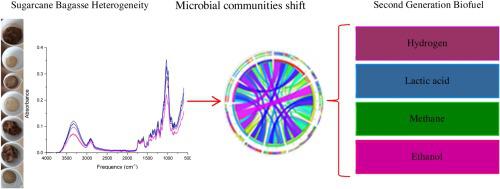Industrial Crops and Products ( IF 5.9 ) Pub Date : 2020-11-25 , DOI: 10.1016/j.indcrop.2020.113120 Laís Américo Soares , Edson Luiz Silva , Maria Bernadete Amâncio Varesche

|
In order to evaluate the effect of sugarcane bagasse (SCB) heterogeneity and hydrothermal (HT) pretreatment on biofuels production, industrial and laboratorial, rind and pith, hydrothermally pretreated (200 °C for 10 min at 16 bar and 10 g of SCB mixed with 100 mL of water) and untreated sugarcane bagasse (SCB) were used as substrate (10 g/L) in batch reactors at thermophilic condition (55 °C) and initial pH of 6.0. High cellulose content in the hydrothermally (HT) pretreated sugarcane bagasse (SCB) results in hydrogen production (33.7 mmol/L), while lactic acid was the main metabolite produced using laboratorial untreated SCB rind and pith (1.5 and 1.3 g/L, respectively), which caused a decrease in the pH and no hydrogen production. Methane was only observed when industrial untreated SCB pith and rind (5.5 and 3.1 mmol/L), respectively, was used. 16S rRNA sequencing was carried out and at the end of the operation the reactors were fed with untreated laboratorial rind, hydrothermally pretreated industrial rind and untreated industrial pith. Hydrogen-producing bacteria, such as Acetomicrobium (74.4 %) was favored using the HT pretreated fiber, while lactic acid bacteria such as Lactococcus (6.3 %) had a potentially negative effect on the hydrogen-producing bacteria like Thermoanaerobacterium (75.0 %) using laboratorial untreated SCB, since no hydrogen was obtained in this condition. Microorganisms involved in all the anaerobic digestion steps, such as Clostridium (34.4 %), Acetomicrobium (33.4 %), and Methanoculleus (14.8 %) lead to hydrogen, volatile fatty acids (VFA), ethanol, and methane production using industrial untreated SCB. Therefore, this study successfully dissected the detailed microbial community structure and the shift on metabolic pathways as a response of SCB heterogeneity and hydrothermal pretreatment.
中文翻译:

剖析了异质性和甘蔗渣水热预处理在生物燃料生产代谢途径中的作用
为了评估甘蔗渣(SCB)异质性和水热(HT)预处理对生物燃料生产的影响,对工业和实验室,果皮和髓进行水热预处理(在200 bar的温度下于16 bar下进行10分钟,并在其中加入10 g SCB在嗜热条件(55°C)和初始pH 6.0的间歇反应器中,将100 mL水和未处理的甘蔗渣(SCB)用作底物(10 g / L)。经水热(HT)预处理的甘蔗渣(SCB)中的纤维素含量高,可产生氢气(33.7 mmol / L),而乳酸是使用实验室未经处理的SCB皮和髓(分别为1.5和1.3 g / L)生产的主要代谢产物。 ),导致pH值降低且没有氢气产生。仅在使用未经工业处理的SCB髓和皮(分别为5.5和3.1 mmol / L)时才观察到甲烷。进行16S rRNA测序,并且在操作结束时,将未处理的实验室果皮,水热预处理的工业果皮和未处理的工业髓加入反应器中。产氢细菌,例如使用经HT预处理的纤维首选乙微生物(74.4%),而使用未经实验室处理的SCB,乳酸菌(如乳球菌(6.3%))对产氢细菌如嗜热厌氧菌(75.0%)可能具有负面影响,因为没有氢气在这种情况下获得的。微生物参与了所有厌氧消化步骤,如梭菌(34.4%),乙微生物(33.4%)和甲烷菌(14.8%)使用未经处理的工业SCB产生氢气,挥发性脂肪酸(VFA),乙醇和甲烷。因此,本研究成功地剖析了详细的微生物群落结构和代谢途径的变化,以响应SCB异质性和热液预处理。


























 京公网安备 11010802027423号
京公网安备 11010802027423号